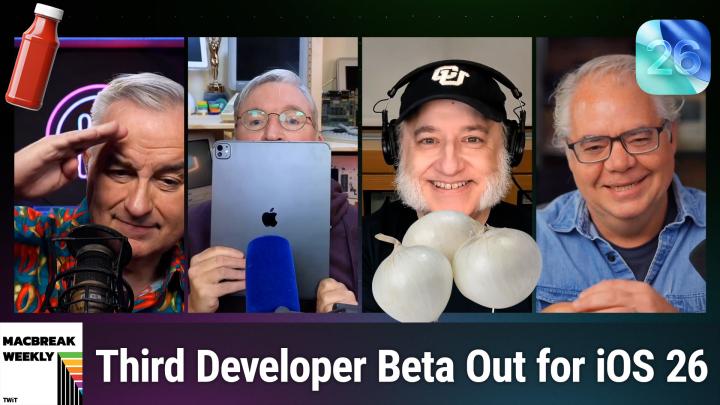Apple’s Shift in Its Foldable Device Strategy
AI-created, human-reviewed.
On a recent episode of MacBreak Weekly, hosts Leo Laporte, Andy Ihnatko, Alex Lindsay, and Jason Snell dove deep into the latest iPhone 17 rumors and Apple's apparent shift in foldable device strategy. The discussion revealed fascinating insights about Apple's priorities and the path forward for innovative form factors.
iPhone 17 Air: A New Direction for Apple
The iPhone 17 Air has emerged as one of the most intriguing products in Apple's upcoming lineup. According to the panelists, this ultra-thin device represents more than just another iPhone variant—it could be Apple's testing ground for future foldable technology. As Jason Snell noted during the discussion, "When the air rumor started happening that was my initial thought was this is how they get to a folding phone is first off, do an entire cycle devoted to making things as thin as possible, and then the next cycle. You've got a two plane thing that unfolds."
The iPhone 17 Air is expected to feature a distinctive sky blue color option, marking a departure from Apple's traditional color palette. However, the device will likely come with trade-offs. Andy Ihnatko pointed out that the Air "is probably not going to be any bargain you can imagine. It'll be as, at least as expensive as a regular iPhone without quite the same features build quality, camera."
Material Changes and Design Evolution
Significant changes are expected in the iPhone 17 Pro's construction. Reports suggest Apple will move away from titanium to aluminum with glass backing, primarily for MagSafe charging and antenna functionality. Leo Laporte mentioned that "aluminum lighter and cheaper than titanium, so you know this might be another response to tariffs is maybe we cut costs in some areas."
The camera system is also getting attention, with rumors of an even more prominent camera bump. Andy Ihnatko expressed enthusiasm for this direction, stating, "I'm pretty excited about the bigger camera bump. I've always been like give me an extra three millimeters if it will make the cameras that much better, if the optics will be that much clearer, that much better."
Why Apple Paused Foldable iPad Development
Perhaps the most significant news discussed was Apple's decision to pause work on the foldable iPad. According to reports from DigiTimes, Apple has shifted focus away from this larger foldable device to concentrate on the foldable iPhone. Jason Snell explained the reasoning: "This is the product that nobody can make any sense of, cause it's like is it an iPad, is it a Mac book? It's like it's huge, so it's like it folds, then it's like a laptop, but it's running iPadOS. What does that mean?"
The foldable iPad presented unique challenges in terms of user experience and market positioning. Andy Ihnatko noted that "there hasn't been any demonstration in the marketplace that anybody really, really wants this," while acknowledging the appeal of "being able to transport a 14-inch tablet in the space of a paperback book."
Foldable iPhone: The Real Prize
While the foldable iPad is on hold, the foldable iPhone appears to be moving forward. Reports indicate that Apple's foldable iPhone has reached P1 (first prototype) status, representing significant progress toward a manufacturable product. The device is expected to function as a regular iPhone that unfolds into something resembling an iPad mini.
Andy Ihnatko emphasized Apple's approach to solving technical challenges: "Apple, the stacks rumors stacking up about the foldable iPhone include things like they wanted to solve the problem of we don't want to have that ditch in the middle of the screen where the hinge is." This attention to detail reflects Apple's typical perfectionist approach to new product categories.
Market Positioning and Pricing Strategy
The discussion revealed Apple's evolving product line strategy. With potentially five iPhone models in the lineup, including the iPhone 17 Air, Apple can afford to experiment with premium, low-volume products. Jason Snell observed, "Once you've got five iPhones, it's like what Samsung learned Once you've got five, six models, you can afford to do a model that is going to be really expensive. You're going to make a lot of money on each one you sell, but the volume is not going to be huge."
The foldable iPhone, when it arrives, is expected to cost at least $2,000, positioning it as a premium offering for specific use cases. As Jason Snell noted, "I always travel with an iPad and you've got to have a phone with you right? So if I was traveling a lot, I would seriously consider a product like this because it would get me. You know, my iPad would be with me in my pocket at all the time."
The Path Forward
Apple's strategy appears to be methodical and purposeful. The iPhone 17 Air serves as a stepping stone to foldable technology, allowing Apple to master ultra-thin construction before attempting the more complex engineering required for foldable devices. Meanwhile, focusing on the foldable iPhone rather than the foldable iPad represents a more pragmatic approach to market entry.
The discussion on MacBreak Weekly highlighted how Apple continues to balance innovation with practicality, ensuring that new form factors solve real user problems rather than simply showcasing technical capabilities. As the iPhone 17 lineup approaches, it's clear that Apple is building toward a future where foldable technology becomes a natural extension of the iPhone experience, rather than a standalone category searching for its purpose.
